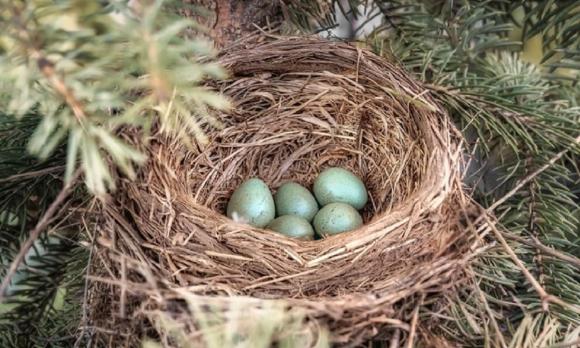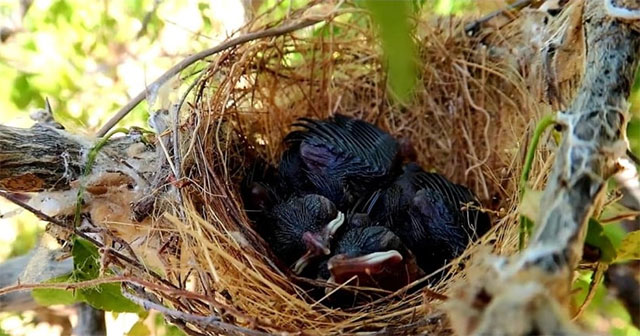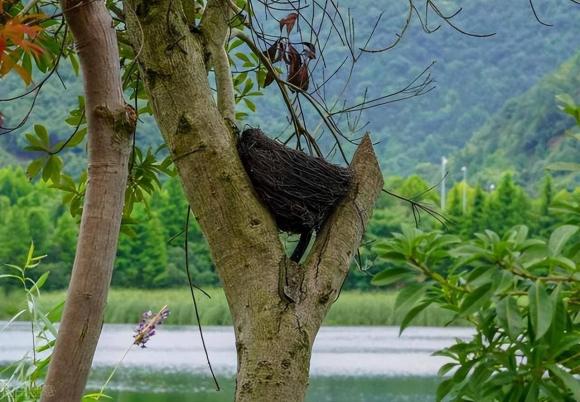Birds have a skillful nest-building ability, using their small beaks to create a beautiful and sturdy structure. But have you ever wondered why bird nests are often built upwards, even in stormy weather?
Why do bird nests often point upwards?
Every species has its own habits and survival strategies, and birds are no exception. The habit of building nests on trees and pointing them upwards originated from the following reasons.

Why do bird nests often point upwards?
Protecting the nest from rainwater
It may seem illogical, but the fact that bird nests remain intact regardless of harsh weather is evidence of their intelligence.
The design of a nest pointing upwards can help prevent water from seeping in – a common weather issue they often face. This design allows rainwater to quickly drain out, facilitating a faster drying process as the nest receives ample sunlight and wind after the rain. As a result, the birds in the nest, especially the young ones, are minimally affected by moisture in the shortest time possible, and the nest itself becomes more durable by avoiding prolonged water exposure.

Protecting the nest from rainwater
Evading predators
Avoiding predators is also one of the reasons why bird nests often point upwards. Birds have many natural enemies, such as squirrels, foxes, and cats. The upward-facing opening helps conceal the birds in the nest from the searching eyes below, providing them with increased safety.
Furthermore, when predators spot a bird’s nest, they often inspect its surface beforehand. It is difficult for the prey animal below to determine the true location and entrance of the bird’s nest. This is another reason why bird nests often point upwards.
How do birds withstand rain and wind?
In addition to the upward-facing nest design for quick water drainage and drying, birds have various ways to withstand sudden rain showers.

How do birds withstand rain and wind?
Being highly sensitive to weather changes, birds can act promptly to protect their nests and themselves during heavy rainstorms. Some species use dry leaves or feathers as a shelter against the rain, while others choose to relocate their nests to covered locations.
Through their songs, many bird species communicate information about the weather to their peers, signaling them to find shelter before heavy rain or storms arrive.
Their plumage also serves as protection against rain. Bird feathers often have waterproof characteristics, allowing water to glide over and trickle down without permeating the skin. The insulating properties of feathers also keep the birds warm during cold rainy weather.
Some bird species utilize the unique structure of their beaks to groom their feathers, ensuring they are clean and smooth. This prevents rainwater from being retained on their bodies.
To avoid rain, some birds choose nesting spots on large tree branches, protruding parts of rock walls, or tree hollows.
Protecting the Nest from Rainwater
Bird nests are engineered to withstand harsh weather, and their upward design prevents water from seeping in. This quick drainage system, coupled with ample sunlight and wind exposure, ensures the nest dries rapidly after rainfall. As a result, the birds, especially the young, stay dry and comfortable, and the nest maintains its structural integrity by avoiding prolonged water damage.
Evading Predators
The upward-facing opening of the nest provides an additional layer of protection from predators like squirrels, foxes, and cats. This orientation helps conceal the birds from prying eyes below, giving them an extra measure of safety. Furthermore, when predators do spot a nest, the upward design makes it challenging for them to pinpoint the exact location and entrance, thus confusing them and increasing the chances of the birds’ escape.
In addition to the upward design of their nests, birds have evolved several strategies to withstand heavy rainstorms and windy conditions. Some species use natural shelters like dry leaves or feathers to protect themselves from the elements, while others relocate their nests to more covered locations. They are highly sensitive to weather changes and can act promptly to ensure their safety.
The Role of Feathers and Beaks
Bird feathers are often waterproof, allowing rainwater to glide off without permeating the skin. Feathers also provide insulation, keeping birds warm during cold, rainy weather. Additionally, some species use their beaks to groom their feathers, ensuring they are clean and smooth, which further aids in rainwater runoff.
Communication and Nest Location
Birds also communicate weather changes through their songs, alerting their peers to find shelter before storms arrive. When choosing nesting spots, some birds opt for large tree branches, protruding rock walls, or tree hollows, providing natural protection from the rain and wind.






























